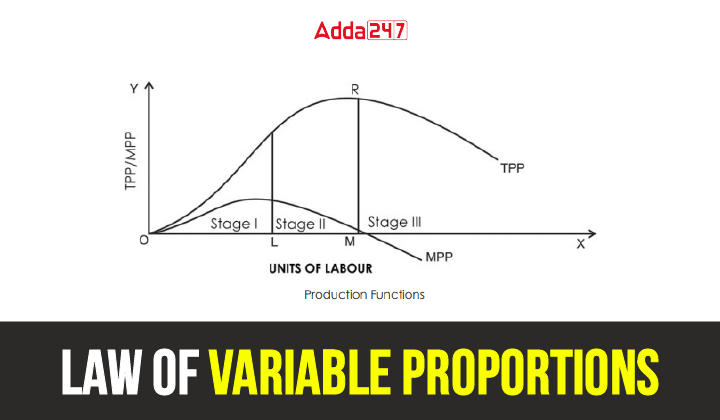Table of Contents
The Laws of Production are fundamental principles that explain the relationship between inputs and outputs in the production of goods and services. These laws offer valuable insights into resource allocation, production efficiency, and the interplay between various factors of production. Notably, the Law of Variable Proportion and the Law of Returns to Scale are key components that influence production processes and economic decisions. This article will explore these laws of production in detail.
Law of Variable Proportion Overview
In economics, the notion of cost and producer equilibrium is managed by the Law of Production. It’s a critical part of economics since it assists a company in deciding the quantum of produce that will affect the utmost gains. It also specifies the company’s multiple variables and fixed costs. The Law of variable proportion focuses on the linkage between the variable factors of production and the production volume.
What are the Laws of Production?
The laws of production in economics are related to the notions of cost and equilibrium of production output. It’s an important aspect of economics as it helps the company determine the degree of production that leads to maximum profit. It also defines the many fixed and variable costs of the business. There are two laws of production- the Law of Variable Proportion and the Law of Return to Scale. In this article, we will discuss the Laws of Variable Proportion in detail.
Types of Laws of Production
The Laws of Production consist of two main principles: the Law of Variable Proportion, also known as the Law of Diminishing Marginal Returns, which explains how adding more of a variable input can lead to diminishing additional output; and the Law of Return to Scale, which examines how increasing all inputs in equal proportions affects overall output, with three possible outcomes – increasing returns, constant returns, or decreasing returns to scale. Together, these laws provide essential insights into the efficiency and behaviour of production processes in different economic contexts.

Law of Variable Proportion
It states that when the volume of one factor of production is raised while keeping all other factors constant, it results in the decline of the marginal product of that factor. The law of variable proportion is also understood as the Law of Proportionality. When the variable factor becomes more, it can result in a negative value of the marginal product.
The law of variable proportion can be concluded as “When the variable factor is raised while keeping all other factors constant, the total product will increase originally at a higher rate, it’ll be increasing at a lower rate and ultimately there will be a decline in the rate of the product.”
Assumptions of the Law of Variable Proportion
The law of variable proportion holds good under certain circumstances, which will be explained in the lines below.
- A constant state of Technology: It’s assumed that the state of technology will be constant and with advancements in the technology, the production will upgrade.
- Variable Factor Proportions: Another assumption of the Law of Variable Proportion is that factors of production are variable. The law isn’t valid, if factors of production are fixed.
- Homogeneous factor units: This assumes that all the units manufactured are identical in quality, volume and price. In other words, the units or goods are homogeneous in nature.
- Short Run: This assumes that this law is appropriate for those systems that are operating for a short term, where it isn’t possible to alter all factor
Stages of the Law of Variable Proportion
There are three stages of the law of variable proportion which are detailed below:
First Stage- Increasing Return to a Factor
In the initial stage, every additional variable factor adds further and further to the total output. It means TP increases at a vast rate and MP of each variable factor rises. Better utilization of fixed factors and increases in the effectiveness of a variable factor due to specialization are the significant factors accountable for higher returns.
The increasing returns to a factor stage have been shown in the given illustration between O to L. It implies. TP increases at an increasing rate and MP rises till it reaches its maximum point’ L’. which marks the end of the first phase.
Second Stage- Diminishing Return to a Factor
In the second phase, incorporating each additional variable input leads to a progressively smaller increment in output. This implies that the Total Product (TP) starts to increase at a slower pace, and the Marginal Product (MP) of the variable input declines as the input quantity grows. The primary reason for this diminishing returns phenomenon is the disruption of the optimal balance between fixed and variable inputs.
This second stage concludes at the juncture labelled ‘M’ where MP becomes zero while TP reaches its peak at point ‘R.’ This second stage is of significant importance as rational producers naturally strive to operate within it. This is because TP attains its highest value here, and the MP associated with each variable input remains positive.
Third Phase- Negative Return to a Factor
During the third phase, the incorporation of extra variable inputs leads to a reduction in Total Product (TP). Moreover, the Marginal Product (MP) turns negative at this point. Consequently, this stage is termed as experiencing negative returns to a factor. The fundamental reason for this phase lies in the insufficient coordination between the variable and fixed inputs.
The third stage commences right after point ‘M’ on the MPP curve and extends to a point on the TPP curve. The Marginal Product for each variable input remains negative throughout these three stages. Consequently, no rational firm would intentionally opt to function within this phase.
Conclusion
These laws collectively form the bedrock upon which sound production strategies and economic policies are built. They guide producers and policymakers in making informed choices that optimize output, minimize costs, and foster sustainable growth in economies.
Download UGC NET Commerce Study Notes PDF
The direct Link to Download UGC NET Commerce Study Notes PDF has been mentioned below. Candidate can download Law of Variable Proportion Study Notes PDF which has been mentioned below.
Download Law of Variable Proportion Study Notes PDF




 UGC NET Commerce Syllabus 2025 PDF Downl...
UGC NET Commerce Syllabus 2025 PDF Downl...
 UGC NET Teaching Aptitude Questions Answ...
UGC NET Teaching Aptitude Questions Answ...
 UGC NET Philosophy Syllabus 2025 PDF Dow...
UGC NET Philosophy Syllabus 2025 PDF Dow...




